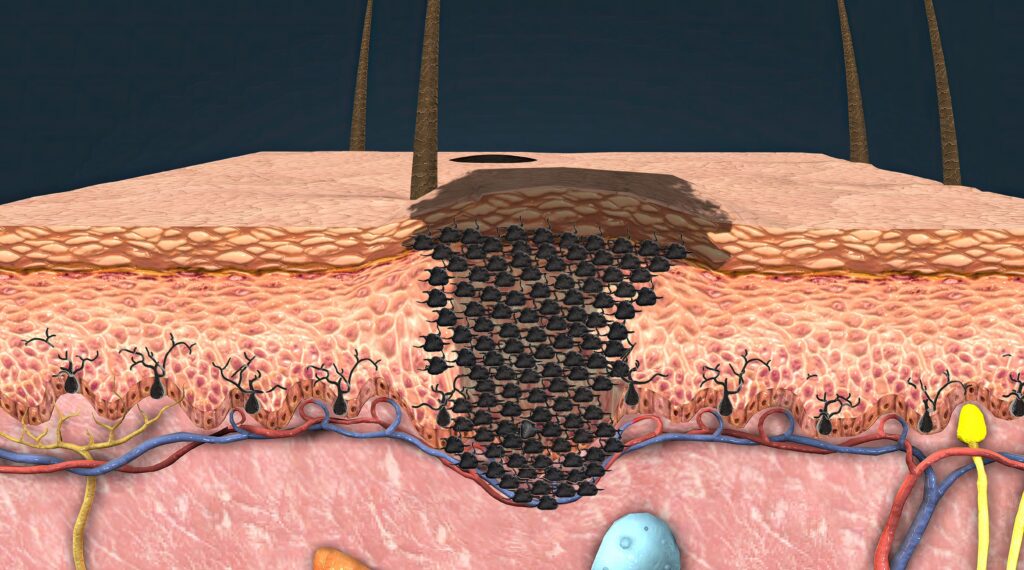Malignant melanoma, a potentially life-threatening form of skin cancer, demands a treatment approach that combines efficacy with precision. While Mohs surgery has long been celebrated for its effectiveness in treating basal cell and squamous cell carcinomas, its role in managing malignant melanoma has been a topic of debate. However, recent advancements, including the utilization of MART-1 staining techniques, have expanded the potential of Mohs surgery in treating this aggressive form of skin cancer.
Can Mohs Surgery Treat Melanoma?
Traditionally, melanoma has been considered less amenable to Mohs surgery due to its propensity for deeper invasion and the potential for metastasis. However, emerging research and clinical experience have demonstrated that Mohs surgery can be a viable option for select cases of melanoma, particularly those diagnosed at an early stage or located in cosmetically sensitive areas. “This is particularly true for melanoma in situ and lentigo maligna melanoma,” says Dr. Adam Mamelak, fellowship-trained Mohs surgeon and board-certified Micrographic Dermatologic Surgeon .
The Power of Precision: Mohs Surgery for Melanoma
Mohs surgery’s hallmark precision makes it well-suited for managing melanoma, especially when the tumor is localized and has clear margins. Unlike conventional excision methods, Mohs surgery allows for real-time microscopic examination of tissue layers, enabling the dermatologist to precisely delineate the extent of tumor involvement and ensure complete removal while minimizing tissue loss.
Introducing MART-1 Staining: Enhancing Visualization of Melanoma Cells
Central to Mohs surgery’s success in treating melanoma is the use of MART-1 staining techniques. MART-1, also known as melanoma antigen recognized by T-cells 1, is a protein expressed by melanocytes, the cells from which melanoma originates. By utilizing MART-1 staining, dermatopathologists can selectively highlight melanoma cells under the microscope, facilitating their identification amidst surrounding normal tissue.
How MART-1 Staining Works
MART-1 staining involves the application of specific antibodies that bind to the MART-1 protein within tissue sections obtained during Mohs surgery. These antibodies are tagged with a fluorescent or chromogenic marker, allowing melanoma cells to be visualized under the microscope. This targeted staining technique enhances the contrast between melanoma cells and surrounding tissues, making it easier for dermatopathologists to accurately assess tumor margins and ensure thorough removal.
The Role of MART-1 Staining in Mohs Surgery for Melanoma
In Mohs surgery for melanoma, MART-1 staining serves as a valuable adjunct to standard microscopic examination, offering enhanced visualization of melanoma cells and facilitating more precise margin assessment. By identifying residual tumor cells that may otherwise be missed, MART-1 staining helps ensure complete excision of the melanoma while preserving surrounding healthy tissue to the greatest extent possible.
Navigating the Complexities of Melanoma Treatment
While Mohs surgery with MART-1 staining holds promise for certain cases of melanoma, it’s important to recognize that not all melanomas are suitable for this approach. Factors such as tumor thickness, location, and histological subtype must be carefully considered when determining the most appropriate treatment strategy. Additionally, interdisciplinary collaboration between dermatologists, dermatopathologists, and oncologists is essential for optimizing patient care and outcomes.
In Conclusion
Mohs surgery, coupled with MART-1 staining techniques, represents a valuable tool in the armamentarium for treating malignant melanoma. By harnessing the precision of Mohs surgery and the enhanced visualization provided by MART-1 staining, dermatologists can offer patients with select cases of melanoma a treatment option that balances efficacy with cosmesis. As research and technology continue to advance, Mohs surgery’s role in managing melanoma is likely to expand, providing new hope for patients in their battle against this challenging disease.
**Dr. Mamelak authored the book chapter on the use of Mohs surgery for the treatment of melanoma in “Mohs Surgery and Histopathology: Beyond the Fundamentals” (Cambridge University Press, New York, NY, 2009), the reference textbook used by fellow physicians and surgeons when training and perfecting the Mohs technique.

